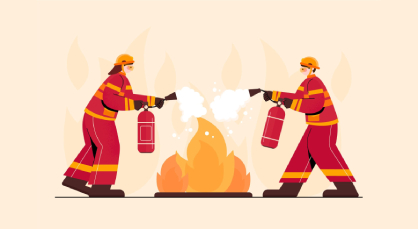Fire Safety & Emergency Preparedness for Factories in Punjab: What You Must Know – The Safety Master

Fire Safety & Emergency Preparedness for Factories in Punjab: What You Must Know
November 11, 2025
Why Choosing a Safety Consulting Partner in Punjab Matters — 5 Selection Criteria
November 13, 2025
Industrial growth in Punjab has been remarkable over the last few decades. From textile and food processing to pharmaceuticals, automotive, and heavy engineering, factories here form the backbone of the state’s economy. However, with rapid industrialization comes an equally critical responsibility—ensuring fire safety and effective emergency preparedness. Fires in factories not only cause devastating financial losses but also endanger human lives, disrupt supply chains, and tarnish reputations. For responsible industries, fire prevention is not optional—it’s an ethical, legal, and operational necessity. This detailed guide by The Safety Master explores how factories in Punjab can strengthen their fire safety and emergency response systems, comply with legal standards, and build a culture of safety that protects both people and property.
Understanding Fire Risks in Industrial Environments
Factories are complex environments where combustible materials, electrical equipment, and chemical reactions coexist. Even a small error—a leaking valve, a faulty wire, or improper storage—can lead to catastrophic fires. Common causes of factory fires include: electrical short circuits from overloaded wiring, improper insulation, or damaged cables; flammable materials like paints, solvents, and fuels; human error such as smoking or welding in restricted areas; mechanical friction from overheated equipment; and chemical reactions in pharmaceutical or fertilizer production. Recognizing these risks is the first step toward building an effective prevention strategy.
The Legal Framework for Fire Safety in Punjab
Factories in Punjab must comply with multiple safety regulations to minimize fire hazards. The key frameworks include The Factories Act, 1948, which mandates adequate fire prevention and response measures; Punjab Fire Safety Rules, which outline design and inspection standards; the National Building Code (NBC) of India, 2016, which specifies fire safety design and maintenance requirements; and the Occupational Safety, Health and Working Conditions Code, 2020, which updates occupational safety provisions for factories. Adhering to these laws isn’t just about compliance—it’s about creating a safe working environment and avoiding penalties or shutdowns.
Why a Fire Audit Is Essential for Every Factory
A comprehensive Fire Audit evaluates the existing fire safety systems, identifies potential hazards, and recommends corrective actions. It’s not just a formality—it’s an in-depth examination of your facility’s preparedness against fire incidents. A Fire Audit typically covers assessment of detection and suppression systems, review of electrical installations, inspection of storage and handling of flammable substances, evaluation of evacuation routes, and examination of fire drills and emergency plans. Benefits include: prevention of life and property loss, compliance with regulations, enhanced stakeholder confidence, and reduced downtime. Regular fire audits are essential, especially for high-risk industries like petrochemicals, textiles, food processing, and pharmaceuticals.
Integrating Safety Through a Safety Audit
While a Fire Audit focuses on fire-specific hazards, a broader Safety Audit evaluates all aspects of workplace safety—from machinery and ergonomics to chemical management and environmental safety. Safety Audits identify visible and hidden risks, help implement risk control measures, support ISO 45001 certifications, and ensure continuous safety improvement. Conducting periodic Safety Audits not only satisfies statutory requirements but also strengthens your safety culture and demonstrates your commitment to worker well-being.
The Role of Process Safety Management (PSM)
For industries dealing with chemicals, gases, or complex manufacturing operations, implementing Process Safety Management (PSM) is critical. PSM is a systematic framework designed to prevent the release of hazardous substances that could lead to fires, explosions, or toxic exposures. Effective PSM includes hazard identification, safe equipment design, standard operating procedures, employee training, incident investigation, and emergency planning. Implementing PSM ensures that every stage of manufacturing—from raw material storage to dispatch—is safeguarded against potential hazards.
Conducting a Hazop Study: Identifying Hidden Risks
A Hazop Study (Hazard and Operability Study) is a structured and systematic technique used to identify potential hazards and operational problems in industrial processes. It’s especially vital for chemical, pharmaceutical, and oil & gas plants in Punjab that deal with complex systems. During a Hazop Study, multidisciplinary teams analyze each process step to detect deviations from normal operations that could lead to accidents. Benefits include: early detection of design flaws, reduced accident risk, improved process reliability, and compliance with global safety standards. By incorporating Hazop Studies at design, commissioning, and operation stages, factories can proactively control risks instead of reacting to disasters.
Emergency Preparedness: Building a Robust Response Plan
Fire safety isn’t just about prevention—it’s also about being prepared to respond effectively when an emergency strikes. Every factory in Punjab should have a clear, actionable Emergency Response Plan (ERP) tailored to its operations. Key elements include risk assessment, defined roles and responsibilities, communication protocols, evacuation routes, fire-fighting arrangements, regular drills, and coordination with external agencies like local fire departments and hospitals. Preparedness minimizes confusion, speeds up evacuation, and reduces damage during real emergencies.
Training: The Cornerstone of Safety Culture
Even the best safety equipment is useless if employees don’t know how to use it. Continuous training develops awareness, confidence, and quick response during emergencies. Types of training include basic fire-fighting, evacuation drills, electrical and chemical safety, first aid, and incident reporting. The Safety Master offers industry-specific modules that equip employees to handle fire emergencies confidently and effectively.
Modern Fire Safety Technologies for Punjab Factories
Advancements in technology have transformed industrial fire safety systems. Factories can now integrate smart tools that detect, alert, and suppress fires faster than ever. Modern solutions include automatic detection and alarm systems, IoT-based smoke detectors, gas leak sensors, sprinkler systems, thermal imaging for hotspot detection, and integrated control panels for central monitoring. Investing in these technologies allows early detection and faster response to fire hazards.
Building a Safety-First Culture
Safety isn’t a one-time activity—it’s a continuous process that must be woven into an organization’s culture. Leadership plays a key role in this transformation. To build a sustainable safety culture, set clear safety policies, reward proactive behavior, involve employees in safety discussions, use incident data to improve systems, and allocate budgets for safety initiatives. When every employee—from management to workers—takes ownership of safety, accident likelihood drops significantly.
The Safety Master: Your Partner in Industrial Safety Excellence
The Safety Master is a trusted name across India for comprehensive industrial safety services. With expertise in fire safety, risk assessment, process safety, and compliance, we help factories in Punjab build safer workplaces and achieve operational excellence. Our services include Fire and Safety Audits, Emergency Response and Crisis Management Planning, Process Safety Management and Hazop Studies, Safety Training Programs, and Implementation of Safety Management Systems. We don’t just audit—we partner with organizations to create lasting change and sustainable safety performance.
Conclusion
Fire safety and emergency preparedness are not optional compliance measures—they’re essential pillars of responsible manufacturing. Factories in Punjab must take proactive steps to prevent, prepare for, and respond to fire-related emergencies. Conducting regular Fire Audits, Safety Audits, and implementing Process Safety Management systems backed by a thorough Hazop Study can save lives, protect assets, and ensure long-term operational continuity. At The Safety Master, we believe prevention is the best protection. Let’s make every factory in Punjab a safer place to work, innovate, and grow.
Ready to enhance your factory’s fire safety standards?
Visit The Safety Master to learn more about our fire and process safety solutions designed for your industry.




